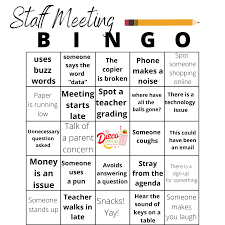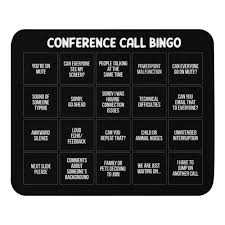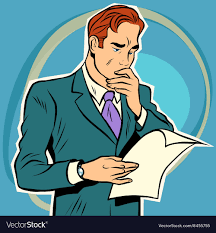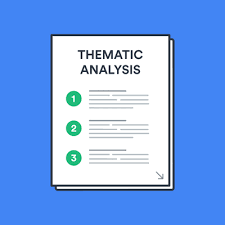Introduction
Do we use thematic analysis in the workplace, without knowing it?
Or have you played the game Meeting Bingo?
Yup, that age-old game played when stuck in a boring meeting, trying to see who could get a full house first.

The game may have changed from meetings being attended in person at the office, where waiting for words like “Blue sky thinking”, or “Let’s shelve that”, or “Let’s take that offline” where the words being recognised, to meetings being attended virtually, where the words or behaviours that are looked for could include “we will start when everyone has joined”, or “I may have to leave for a moment to answer the doorbell” or “loud typing noises” or a “Please excuse the Dog Barking”.

But what does this have to do with Thematic Analysis? Well, the short answer is that Meeting Bingo is a form of pattern recognition.
In the same way that when you read a sentence or paragraph you are not going to read every word, but pattern recognise some words, making sure that all the words you have read and recognised make sense at the end, and as we grow older we become faster and more accurate at this practice

Question : – How many words did you actually read in that last paragraph?
Meeting bingo is the same, you will read the words on the sheet, but will then every time you refer back to your meeting bingo card (if you have one) you will recognise the patterns of the word.
However, we also pattern recognise in audible conversations, listening to the sentence, and making applied guesses as to what words will come next, so we can understand what is being said to us, and determine the points that are being raised at the same time the sentence is finished.

This may not be Thematic Analysis in its purest form, but pattern recognition and accounting for those patterns, to understand the theme(s) being presented, is what Thematic Analysis is.
Discussion
What is Thematic Analysis?
In short, it is as I have described, recognising the patterns of words, in documents or in audible conversations to gain an understanding of the themes being presented.

My research project will be using what has been described as semi-structured interviews (and I will be discussing them in the next blog), to collect information about how people perceive technologies when tasks are technologically automated.
For example how secure do you feel your job is, or aspects of your job when a computer can complete the building of that big report for your boss you do every month that takes a day to complete?
The information collected, through the semi-structured interviews, can be analysed in multiple different ways, however, because I am looking at people’s perceptions, fears, ideas, etc, about technology, these can not always be drawn out and understood if I am just counting specific words or sentences, as would normally be done in a survey.
Using Thematic Analysis the words spoken within the interviews can be used to identify themes and sub-themes.
For example; I am interviewing David, he works within the call centre of a very large company that makes toys, and he has recently seen his organisation implement a new computer system that manages customer telephone calls. Part of this computer system can report on how many calls a customer service person answers, and can also report if the customer has called to either complain or request some information.

These two tasks David completes on a daily basis, and so during the interview, David discusses how he feels about not having to do these tasks every day. David is happy that he does not have to spend hours looking through lists of calls made to the organisation, and determining if it is a complaint or a request for information, but at the same time he feels that the responsibility for completing the task has been removed, and therefore he feels that either his job may become obsolete, or he will be asked to go part-time.
It also becomes apparent when discussing this with David that he also is not sure what other tasks he may be asked to perform, or if he can do those tasks because the time spent completing the reports is now free or spare.
So from this very simple example, several themes could be identified. 1. David is worried his job is going to change. 2. David is worried that his job may become obsolete, or become part-time. 3. David is worried about the spare time he now has available. 4. David is worried about what any new tasks he may be asked to perform will be. 5. David is worried that he may not be able to complete the new tasks. 6. David is worried that he will not have the same responsibilities he had before.
So do we use Thematic Analysis without knowing it, when reading documents?
I would say we do, to a point.
The documents may be a list of things, an email, a customer letter, a memo reporting a new order that has been won, an information pack about changes within the department, or organisational direction change, or even a PowerPoint presentation full of bullet-pointed sentences, that is used within a meeting.
We analyse these documents to understand the sentiment, what the document is trying to say, and also how it is saying it, and we do this through the words that are used, creating patterns of words that suggest new points or reinforce a point or set of points.
Moreover, you will not actually read the full document, but pattern recognise specific words, reading others to make sure you understand the sentence, therefore reading and digesting the document quickly.
But do we pattern recognise when engaging in conversation?
Again I would suggest that we do, but again to a point.
However, there are some differences that we need to take into account between recognising the patterns within a document and those that we recognise within a conversation.
Patterns of words are still recognised, and these could also be understood to be highlighting any point or set of points the speaker is trying to make, however, other aspects that are not present within a document, could also be recognised as patterns, and these could include pauses between words, or voice inflexions, that for example, could include a slight raising of the voice tone, and this could suggest a question, or an invitation to reply.
In Conclusion
So do we use Thematic analysis when we are working?
I would suggest we do, to a point.
This form of thematic analysis may not be as rigorous as that, used by a social researcher analysing interviews, speeches made by an individual(s) or even historical documents, but we all do a version of pattern recognition, enabling us to discover and understand the themes contained within the conversation or document.
Taking into account the differences between the type of analysis we could do on a document, and that contained within a conversation, it could be suggested that we derive greater amounts of information in regard to a single, or set of points or themes from a conversation or speech that we would do from a document.
So I would suggest we do, but we may not always know it




